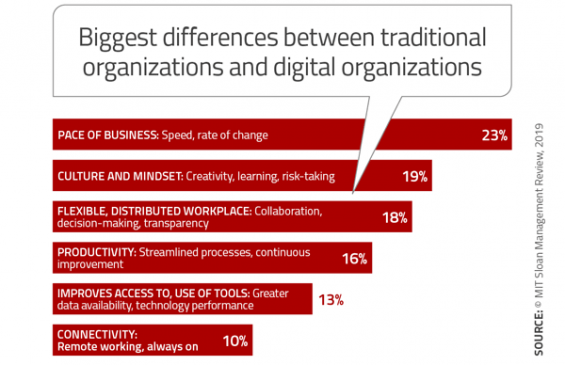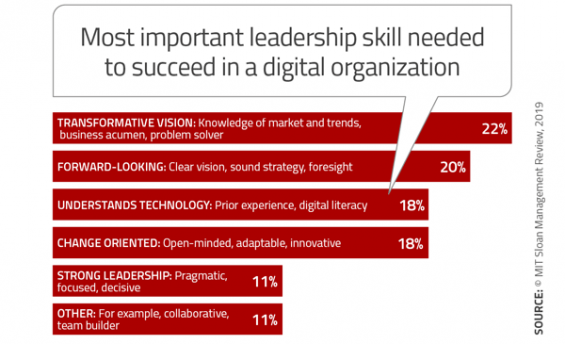The banking industry is trying to respond to an increasingly turbulent business environment, where legacy leadership and existing cultures are being challenged. In many instances, the legacy culture becomes a barrier to required change needed to become digital banking organizations. Not only do leaders need to articulate a vision for a future of increasing customer expectations, greater competition, new delivery channels and advancing technology, but also provide the resources to become digital technology organizations.
Some people argue that completely new leadership skills will be required to survive in the digital age. Others believe that leaders should go back to the essentials established decades ago, not letting change distract or disrupt an organization on a managerial level.
To these points, a research project conducted as part of a 5-year collaboration between MIT Sloan Management Review and Deloitte, found that a blend of both perspectives may be required. In other words, while core leadership skills will stay the same, digital disruption will require new skills to be added to the ‘leadership handbook’.
Now more than ever, bank and credit union leaders need to adjust to the increased pace of change in the industry. They also need to deal with the effects of hundreds of small fintech and big tech firms competing for customers who do their banking purely on their mobile phone, as well as with the disruptive conflicts between legacy bankers and the new wave of change agents within their organizations. In other words, today’s leaders need to embrace change, take risks and disrupt themselves.
Read More:
- 7 Essentials of Digital Banking Transformation Success
- Digital Transformation Demands a Culture of Innovation

Industry Cloud for Banking from PwC
PwC’s Industry Cloud for Banking applies our deep industry knowledge to your specific business needs

Are You Ready for a Digital Transformation?
Unlock the potential of your financial institution's digital future with Arriba Advisors. Chart a course for growth, value and superior customer experiences.
What Makes Digital Leadership Different?
The leadership skills of the past are the foundation needed in a digital organization, but they aren’t enough by themselves. When more 3,300 leaders were asked by MIT SMR what the single most important skill was to succeed in a digital workplace, the presence of a ‘transformative vision’ was ranked slightly higher than a clear, ‘forward-looking’ vision (22% and 20% respectively).
By transformative vision, respondents to the MIT SMR research meant leaders should have the ability to anticipate markets and trends, make savvy business decisions, and solve tough problems in turbulent times. In other words, embrace change and take risks based on multiple possible futures.
The third most mentioned skill that was deemed important for leadership success in a time of digital change was the ability to ‘understand technology’. This has been found to be a major skills gap with traditional banking leaders as well as with their board of directors. At most financial organizations, digital literacy above middle management is almost non-existent.
In fact, the principal researchers from MIT CISR. Peter Weill, Stephanie Woerner, Thomas Apel and Jennifer Banner found that at companies in all industries, earning more than $1 billion in revenue annually, only about a quarter of them had three or more board members who were considered ‘digitally savvy’. For the purposes of this research, ‘digitally savvy’ was defined as, “understanding, through experience, how digital technologies such as social, mobile, analytics, the cloud, and the ‘Internet of Things,’ will impact company success in the next decade.”
Read More: Will IoT Payments Disrupt Role of Traditional Banking Providers?
To increase digital maturity of top management and boards of directors, MIT Sloan suggested the following:
- Provide self-directed learning, require attendance at technology conferences, and/or find digital natives for leaders to learn from.
- Commit to ‘digital tourism‘, including visiting and engaging in conversations with boards and leaders of other successful, tech-driven companies.
- Have multiple digital strategy retreats that focus exclusively on digital threats and opportunities.
- Recruit new leaders who have strong digital experience.
Digital literacy is part of the foundation of the first two leadership skills cited, because leaders who are not digitally adept will struggle to understand the impact, risks and opportunities of digital transformation. This is why we see that the most digitally advanced and innovative financial institutions worldwide are those with leaders from outside the banking industry. Bottom line, it’s hard for historically successful leaders (and organizations) to disrupt themselves.
Finally, tied with the need to understand the impact of digital technology is the need to be open-minded and accepting of change. Obviously, this trait supports all of those traits higher on the list, enabling leaders to respond to a very disruptive environment. The trait also assumes that ongoing learning is occurring to avoid skill set obsolescence.
Traditional Leadership Skills Still Required
Even though a number of new skills are required to succeed at a time of digital transformation, the decades-old fundamentals are still required. In other words, leaders should not let the technological change occurring around them distract. Understanding the basics of communication, prioritization, investment and project management are even more important during times of change. These skills cannot be delegated. They are the foundation for a culture that embraces the potential of digital transformation as opposed to simply providing lip service.
New technology without top-level ownership, involvement, empowerment and communication is a recipe for disaster. Employees and managers at all levels need to have the tools to succeed, including training and the support for ‘disrupting others’ appropriately. This may require the hiring of new digital leaders who can set an example for others. There must also be the opportunity for those embracing digital transformation to advance in the organization.
Combining the Best of Old and New Leadership Skills
The joint research project with MIT Sloan Management Reviewand Deloitte believes what is needed is a healthy blend of both old and new skills. That is: “Leaders who have the core skills cultivated from the insights of the past, but with the agile mindset and digital savvy to allow them to pivot when necessary. In short, leaders who can ‘be the change we seek’.”
According to Deloitte, today’s leaders need flexibility, agility, and a willingness to extend their organization’s capabilities into new and, sometimes unexpected, areas to keep ahead of relentless competition. The goal is to make themselves and their organizational incumbent players ‘undisruptable’.
“CEOs need to continually transform their organizations by ’embracing ambidexterity’ through their leadership — and by infusing others with the same mindset,” state Benjamin Finzi (a managing director and co-lead of Deloitte’s CEO Program), and Scott Baret (a partner and Vice Chairman of Deloitte, leading the US Banking & Capital Markets practice). Leadership ambidexterity requires simultaneously optimizing through aggressive actions that yield efficiencies while exploring new and risky pathways that may ultimately modify the current business model.
Enhancing optimization and exploration simultaneously, particularly in large, legacy financial institutions, can be extraordinarily challenging — yet doable state Finzi and Baret. The larger, more complex, and older an organization, the more it may lean on optimization over risk-taking as a means to growth and profitability. To gain comfort in taking risks and learning from the inevitable failures that come with them, leaders need to cultivate ’emotional fortitude’, which provides a clear-headed expectation of possible failure but does not result in despondency or recklessness.
Emotional fortitude combines a realistic assessment of potential risks and roadblocks with the courage to pursue lofty visions. It involves the tenacious confidence to continue exploring risky bets in the face of repeated failures and the willingness to let go of a treasured project as soon as the signs that justify abandonment arise.

Embracing a Beginner’s Mindset … and More
Deloitte’s Finzi and Baret point out that to fuel a powerful engine of exploration, leaders of digital organizations need to adopt a ‘beginner’s mindset’ — a concept rooted in Zen Buddhism, that leverages the possibilities inherent in not knowing all the answers. Strengthening one’s ability to find moments to keep an exceptionally open mind, put aside all of the answers and knowledge one has gleaned over the years, and listen deeply to differing views and experiences, can lead to breakthrough ideas that may further bend the business model.
As a complement to the creativity of the ‘beginner’s mindset’, CEOs also need to embrace the attribute of ‘disruptive jujitsu’. This characteristic requires recognizing threatening, disruptive patterns from competitors and others in the environment, breaking the patterns into their components, and ultimately finding ways to appropriate selected disruptive elements for their competitive advantage.
Finally, and most importantly, the study from Finzi and Baret emphasizes that digital leaders must make it their passion to discover their customers’ most subtle, unconscious, and often unrecognized needs and desires. Essentially, what will solve the problems that customers have not yet even acknowledged to themselves? This requires finding new and innovative ways to understand the customer’s experience with current services — and then addressing their most deeply-embedded wishes and needs in innovative ways, regardless of whether the consumer is conscious of them or not.
The new leadership model will require that Boards of Directors, CEOs, and all top management constantly reinvent their skills and roles, demanding new perspectives from themselves and their organizations. In striving to create a new leadership model, some failure is inevitable along the way; but without it, banks and credit unions may not survive as we know them today.
Additional Insights into Digital Leadership
The Digital Leadership Initiative, published by MIT Sloan Management Review, explores the growing use of digital technologies in the business landscape. Through a series of annual reports, blogs, articles, and case studies, the exploration examines how companies are cultivating opportunities and addressing risks in a fast-moving, digital market environment.
As more companies strive to develop new digital capabilities, many are making significant changes to their organizational culture, strategy-making process, and talent management efforts. These shifts raise important questions about what it means to lead a digital business. These questions, and more, are the focus of MIT SMR’s Big Ideas Initiative.









